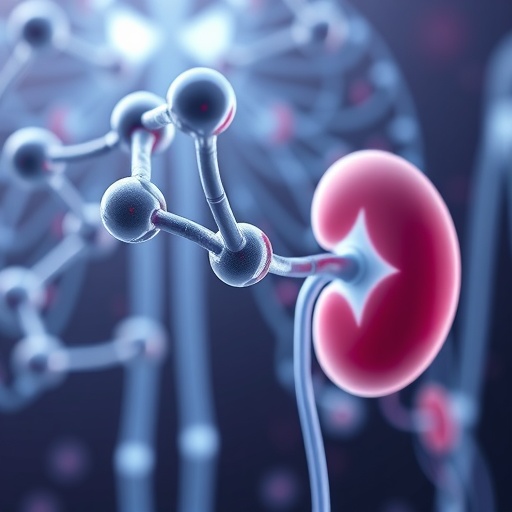Chronic kidney disease (CKD) stands as a formidable global health challenge, progressively impairing the kidneys’ critical ability to filter waste and maintain homeostasis. Affecting an estimated 8–16% of the global population—particularly older adults—CKD often results from diverse underlying conditions, including glomerulonephritis, a complex group of disorders targeting the tiny filtration units within the kidney known as glomeruli. The intricate molecular and cellular pathways guiding CKD progression have long eluded clear definition, complicating efforts to design targeted therapeutic interventions. However, innovative research emerging from Chiba University in Japan sheds new light on the nuanced roles of the chemokine CCL5 in kidney injury and repair, opening promising avenues for precise, cell-specific therapies in CKD management.
Cancerous to immune signaling, C-C chemokine ligand 5 (CCL5) plays a paradoxical role in renal health, acting both as a protector and a pathological instigator depending on the cellular context. Initially identified in T cells as a key chemoattractant for immune cells migrating to inflammatory sites, subsequent work revealed its broader expression, notably in podocytes—specialized epithelial cells enveloping the glomerulus and establishing the final filtration barrier. These discoveries hint at CCL5’s dualistic influence: facilitating immune defense mechanisms while concurrently fostering inflammation and tissue damage. This dichotomy has fueled conflicting interpretations about CCL5’s true impact on kidney disease, prompting the current in-depth investigation.
Led by Professor Katsuhiko Asanuma and his colleagues at Chiba University’s Graduate School of Medicine, this pioneering study meticulously explores CCL5’s complex actions in both human disease and rodent models. Evaluating kidney biopsies from patients with various glomerular diseases alongside mice subjected to Adriamycin-induced nephropathy—a widely recognized experimental analogue for focal segmental glomerulosclerosis—the research uncovers conspicuously elevated CCL5 expression within injured glomeruli, tightly associated with podocyte populations. These data suggest an intrinsic relationship between CCL5 and the structural integrity of the glomerular filtration barrier in pathological states.
Experimental paradigms employing cultured podocytes reveal that exogenous administration of CCL5 confers a measurable survival benefit, mitigating apoptotic cell death and supporting podocyte resilience. Such findings affirm the chemokine’s protective capacity within isolated epithelial cells. Contrastingly, in vivo investigations tell a more convoluted story; mice exhibiting increased CCL5 levels demonstrate pronounced renal impairment marked by enhanced proteinuria, tissue fibrosis, and substantial depletion of podocytes, signifying exacerbated glomerular injury. This confounding dual behavior of CCL5 underscores the necessity to dissect its cell-type–specific effects within the renal microenvironment.
To parse the contributory roles from different cellular sources, the researchers ingeniously applied bone marrow transplantation techniques, replacing marrow from CCL5-deficient donor mice into wild-type recipients. These chimeric mice presented with notably reduced renal damage following injury induction, implicating immune cell–derived CCL5 as a principal agent propagating kidney pathology. Delving deeper into the immunological underpinnings, analysis revealed that CCL5 skews macrophage polarization towards the pro-inflammatory M1 phenotype, simultaneously diminishing reparative M2 macrophage populations. This shift exacerbates tissue inflammation and fibrosis, tipping the balance away from regeneration and towards progressive nephron loss.
Professor Asanuma summarizes this complex interplay by stating that the detrimental immune actions of CCL5 “outweigh its protective role in podocytes,” ultimately driving common CKD features such as proteinuria and glomerulosclerosis. These insights point to a crucial therapeutic conundrum: how to retain and amplify CCL5’s podocyte-supportive functions while mitigating its injurious immune-mediated effects. Current anti-inflammatory approaches in CKD lack such selectivity, often producing systemic immunosuppression with undesirable side effects.
The study’s revelations open an exciting frontier for the development of nuanced, cell-targeted therapeutics that could revolutionize CKD treatment paradigms. By designing drugs that selectively inhibit CCL5 signaling pathways in immune cells, but preserve its action within podocytes, researchers envision a future in which renal injury progression can be substantially slowed, reducing the translation to end-stage renal disease requiring dialysis or transplantation. Such therapies would not only improve renal outcomes but also significantly enhance patient quality of life.
Moreover, the research underscores the broader importance of context-specific molecular targeting in chronic diseases characterized by immune-inflammatory etiologies. This tailored approach may inform strategies beyond nephrology, guiding innovations in autoimmune disease management and tissue regeneration. The Chiba University team’s findings underscore the sophisticated crosstalk between immune and parenchymal cells in kidney disease, a paradigm increasingly recognized as fundamental across organ systems.
Anticipating clinical application, next steps involve the elaboration of small molecules or biologics capable of modulating CCL5 activity with cellular precision. Concurrently, development of biomarkers to monitor CCL5 dynamics in patients could facilitate personalized treatment regimens, optimizing therapeutic efficacy while minimizing adverse effects. Such translational endeavors are pivotal as CKD continues to impose an expanding healthcare burden globally amid aging populations.
Beyond molecular insights, Professor Asanuma’s broader work integrates clinical research on patient education, rehabilitation, and the use of artificial intelligence to support dialysis care, targeting reduction in dialysis dependency and enhancement of kidney function preservation. This multifaceted research portfolio positions Chiba University as a leader advancing comprehensive strategies against CKD’s relentless course.
In sum, the elucidation of CCL5’s dualistic role represents a landmark advance in nephrology, merging immunology, cell biology, and translational science. It offers renewed hope that precision medicine approaches can finally disrupt the vicious cycles of inflammation and damage that characterize chronic kidney disease, leading to more effective and patient-friendly interventions in the near future.
Subject of Research: Animals
Article Title: CCL5’s Dual Role in Kidney Disease: Protective Podocyte Effects Contrasted by Immune-Mediated Injury
News Publication Date: 23-Sep-2025
Web References: https://insight.jci.org/articles/view/173742
Image Credits: Professor Katsuhiko Asanuma at Chiba University, Japan
Keywords: Chronic kidney disease, CCL5, chemokine, podocytes, glomerulus, macrophage polarization, inflammation, kidney injury, proteinuria, glomerulosclerosis, Adriamycin nephropathy, immune cells




